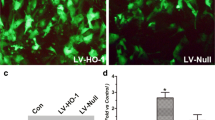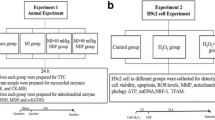Abstract
Background
Although recent studies have found that heme oxygenase (HO)-1 plays an important role in myocardiac cell survival, the precise mechanisms occurring during hypoxia/reoxygenation (H/R) injury remain unclear. Therefore, the aim of this study was to investigate the cytoprotective mechanisms of HO-1 against H/R-induced myocardiac cell apoptosis and to explore whether the Akt signaling pathway contributed to the protection provided by HO-1.
Methods
Cobalt protoporphyrin (CoPP, a pharmacologic inducer of HO-1) was employed to induce the over-expression of HO-1 before H/R in H9c2 cells. Hoechst staining and flow cytometry were used to examine the extent of apoptosis. Furthermore, the effect of HO-1 on Akt, JNK, and the expression of apoptosis-related proteins (c-JUN and Caspase-3) was determined by Western blotting.
Results
The results showed that over-expressed HO-1 could significantly protect myocardiac cells against H/R-induced apoptosis in H9c2 cells. Furthermore, the protein expression of p‑Akt increased and of p‑JNK decreased in the H/R injury H9c2 cells when treated with CoPP. The apoptosis-related proteins c‑Jun and caspase-3 were both inhibited by over-expression of HO-1. At the same time, retreatment with zinc protoporphyrin (ZnPP, a specific inhibitor of HO-1 enzymatic activity) or LY294002 (an inhibitor of Akt1) reversed the HO-1-induced changes.
Conclusion
In summary, our results suggest that HO-1 can decrease H/R-induced myocardiac cell apoptosis; the mechanism may be related to the activation of the Akt signaling pathway and, furthermore, to the inhibition of the JNK/c-Jun/caspase-3 signaling pathway.
Zusammenfassung
Hintergrund
Aktuellen Studien zufolge spielt die Hämoxygenase(HO)-1 zwar eine wichtige Rolle für das Überleben von Myokardzellen, aber die genauen Abläufe bei einer Schädigung durch Hypoxie/Reoxygenierung (H/R) sind nicht geklärt. Daher war es Ziel der vorliegenden Studie, die zytoprotektiven Wirkungen von HO-1 gegen H/R-induzierte Myokardzellapoptose zu untersuchen und herauszufinden, ob der Akt-Signalweg zum HO-1-vermittelten Schutz beiträgt.
Methoden
Kobaltprotoprophyrin (CoPP, ein pharmakologischer Induktor von HO-1) wurde zur Induktion der Überexpression von HO-1 vor H/R in H9c2-Zellen eingesetzt. Mittels Hoechst-Färbung und Durchflusszytometrie wurde das Ausmaß der Apoptose ermittelt. Außerdem wurde die Wirkung von HO-1 auf Akt, JNK und die Expression von Apoptoseproteinen (c-JUN und Caspase-3) mit dem Western-Blot-Verfahren untersucht.
Ergebnisse
Die Ergebnisse zeigten, dass überexprimierte HO-1 in signifikanter Weise Myokardzellen gegen H/R-induzierte Apoptose bei H9c2-Zellen schützen konnte. Darüber hinaus kam es bei H9c2-Zellen mit H/R-Schädigung zur Zunahme der Proteinexpression von p‑Akt und zur Abnahme der Proteinexpression von p‑JNK, wenn sie mit CoPP behandelt wurden. Die Apoptoseproteine c‑Jun und Caspase-3 wurden beide durch Überexpression von HO-1 inhibiert. Gleichzeitig wurden die HO-1-induzierten Veränderungen durch Behandlung mit Zinkprotoporphyrin (ZnPP, ein spezifischer Inhibitor der HO-1-Enzymaktivität) oder LY294002 (ein Inhibitor von Akt1) aufgehoben.
Schlussfolgerung
Zusammenfassend bedeuten die hier vorliegenden Ergebnisse, dass HO-1 die H/R-induzierte Myokardzellapopotose vermindern kann und dieser Vorgang möglicherweise mit der Aktivierung des Akt-Signalwegs sowie außerdem mit der Inhibition des JNK/c-Jun/Caspase-3-Signalwegs in Zusammenhang steht.







Similar content being viewed by others
References
Schachinger V, Zeiher AM (2005) Coronary microcirculation. Pathophysiology, clinical relevance, and importance for regenerative therapy after myocardial infarction. Herz 30:641–650
Janosi RA, Bose D, Konorza T et al (2011) Malperfusion in aortic dissection: diagnostic problems and therapeutic procedures. Herz 36:531–538
Felgendreher R, Cuneo A, Hochreuther S et al (2009) Complication of a complex heart failure: perforation of a sinus Valsalva [corrected] aneurysm. Herz 34:242–246
Zhang Y, Ren J (2014) Targeting autophagy for the therapeutic application of histone deacetylase inhibitors in ischemia/reperfusion heart injury. Circulation 129:1088–1091
Yu P, Zhang J, Yu S et al (2015) Protective effect of Sevoflurane postconditioning against cardiac ischemia/reperfusion injury via ameliorating mitochondrial impairment, oxidative stress and rescuing autophagic clearance. PLoS ONE 10:e0134666
Skyschally A, Schulz R, Heusch G (2008) Pathophysiology of myocardial infarction: protection by ischemic pre- and postconditioning. Herz 33:88–100
Schipke JD, Kerendi F, Gams E et al (2006) Postconditioning: a brief review. Herz 31:600–606
Maines MD (1988) Heme oxygenase: function, multiplicity, regulatory mechanisms, and clinical applications. FASEB J 2:2557–2568
Grosser N, Schroder H (2004) Therapy with NO donors-antiatherogenic and antioxidant actions. Herz 29:116–122
Lundvig DM, Immenschuh S, Wagener FA (2012) Heme oxygenase, inflammation, and fibrosis: the good, the bad, and the ugly? Front Pharmacol 3:81
Alcaraz MJ, Fernandez P, Guillen MI (2003) Anti-inflammatory actions of the heme oxygenase-1 pathway. Curr Pharm Des 9:2541–2551
Yu H, Shi L, Zhao S et al (2015) Triptolide attenuates myocardial ischemia/reperfusion injuries in rats by inducing the activation of Nrf2/HO-1 defense pathway. Cardiovasc Toxicol, doi: 10.1007/s12012-015-9342-y
Park HS, You GE, Yang KH et al (2015) Role of AKT and ERK pathways in controlling sensitivity to ionizing radiation and adaptive response induced by low-dose radiation in human immune cells. Eur J Cell Biol 94(12):653–660
Hemmings BA, Restuccia DF (2012) PI3 K-PKB/Akt pathway. Cold Spring Harb Perspect Biol 4:a011189
Park ES, Kang DH, Yang MK et al (2014) Cordycepin, 3’-deoxyadenosine, prevents rat hearts from ischemia/reperfusion injury via activation of Akt/GSK-3beta/p70S6 K signaling pathway and HO-1 expression. Cardiovasc Toxicol 14:1–9
Zhao P, Li F, Gao W et al (2015) Angiotensin1–7 protects cardiomyocytes from hypoxia/reoxygenation-induced oxidative stress by preventing ROS-associated mitochondrial dysfunction and activating the Akt signaling pathway. Acta Histochem 117(8):803–810
Sun J, Sun G, Meng X et al (2013) Ginsenoside RK3 Prevents Hypoxia-Reoxygenation Induced Apoptosis in H9c2 Cardiomyocytes via AKT and MAPK Pathway. Evid Based Complement Alternat Med 2013:690190
Song JQ, Teng X, Cai Y et al (2009) Activation of Akt/GSK-3beta signaling pathway is involved in intermedin(1–53) protection against myocardial apoptosis induced by ischemia/reperfusion. Apoptosis 14:1299–1307
Wu QQ, Zong J, Gao L et al (2014) Sulforaphane protects H9c2 cardiomyocytes from angiotensin II-induced hypertrophy. Herz 39:390–396
Dhanasekaran DN, Reddy EP (2008) JNK signaling in apoptosis. Oncogene 27:6245–6251
Cao J, Chen J, Xie L et al (2015) Protective properties of sesamin against fluoride-induced oxidative stress and apoptosis in kidney of carp (Cyprinus carpio) via JNK signaling pathway. Aquat Toxicol 167:180–190
Manning AM, Davis RJ (2003) Targeting JNK for therapeutic benefit: from junk to gold? Nat Rev Drug Discov 2:554–565
Martin JH, Mohit AA, Miller CA (1996) Developmental expression in the mouse nervous system of the p493F12 SAP kinase. Brain Res Mol Brain Res 35:47–57
Kuan CY, Yang DD, Samanta Roy DR et al (1999) The Jnk1 and Jnk2 protein kinases are required for regional specific apoptosis during early brain development. Neuron 22:667–676
Gupta S, Barrett T, Whitmarsh AJ et al (1996) Selective interaction of JNK protein kinase isoforms with transcription factors. EMBO J 15:2760–2770
Irving EA, Bamford M (2002) Role of mitogen- and stress-activated kinases in ischemic injury. J Cereb Blood Flow Metab 22:631–647
Zhang Y, Liao H, Zhong S et al (2015) Effect of N‑n-butyl haloperidol iodide on ROS/JNK/Egr-1 signaling in H9c2 cells after hypoxia/reoxygenation. Sci Rep 5:11809
Schipke JD, Nickel F, Gams E et al (2004) Protective effects of a delta-opioid-receptor agonist and an oxygen radical scavenger on postischemic hearts. Herz 29:331–340
Wang B, Zhong S, Zheng F et al (2015) N‑n-butyl haloperidol iodide protects cardiomyocytes against hypoxia/reoxygenation injury by inhibiting autophagy. Oncotarget 6(28):24709-24721
Lakkisto P, Siren JM, Kyto V et al (2011) Heme oxygenase-1 induction protects the heart and modulates cellular and extracellular remodelling after myocardial infarction in rats. Exp Biol Med (Maywood) 236:1437–1448
Wen XR, Fu YY, Liu HZ et al (2015) Neuroprotection of Sevoflurane against ischemia/reperfusion-induced brain injury through inhibiting JNK3/Caspase-3 by enhancing akt signaling pathway. Mol Neurobiol 53:1661–1671
Marte BM, Downward J (1997) PKB/Akt: connecting phosphoinositide 3‑kinase to cell survival and beyond. Trends Biochem Sci 22:355–358
Amaravadi R, Thompson CB (2005) The survival kinases Akt and Pim as potential pharmacological targets. J Clin Invest 115:2618–2624
Chen C, Huo R, Tong Y et al (2011) Systemic heme oxygenase-1 transgenic overexpression aggravates pressure overload-induced cardiac hypertrophy in mice. Cell Physiol Biochem 28:25–32
Funding
This work was supported by the National Natural Science Foundation of China (81500977).
Author information
Authors and Affiliations
Corresponding author
Ethics declarations
Conflict of interest
C. Li, C. Zhang, T. Wang, J. Xuan, C. Su, and Y. Wang state that there are no conflicts of interest.
The accompanying manuscript does not include studies on humans or animals.
Additional information
The authors contributed equally to this work. In detail, C.L. designed the study. T.W., C.Z., J.X., and Y.W. performed the experiments and collected the data. C.L. and T.W. analyzed and interpreted the experimental data. C.L. and T.W. prepared the manuscript.
Rights and permissions
About this article
Cite this article
Li, C., Zhang, C., Wang, T. et al. Heme oxygenase 1 induction protects myocardiac cells against hypoxia/reoxygenation-induced apoptosis. Herz 41, 715–724 (2016). https://doi.org/10.1007/s00059-016-4424-6
Received:
Revised:
Accepted:
Published:
Issue Date:
DOI: https://doi.org/10.1007/s00059-016-4424-6




